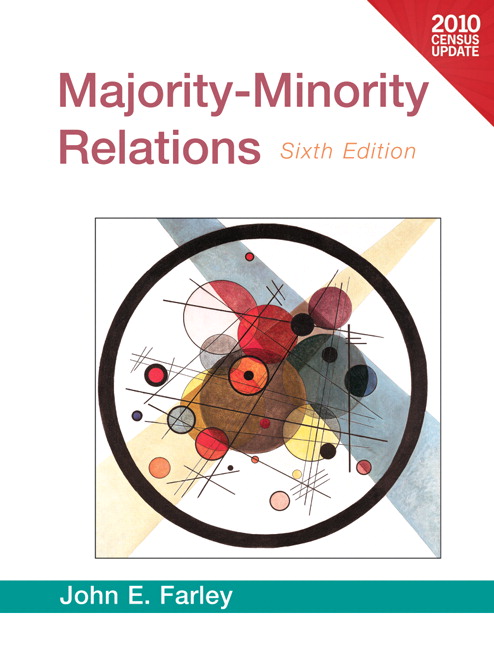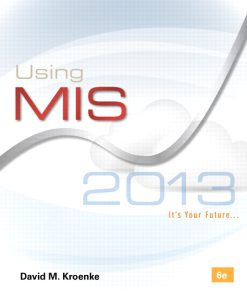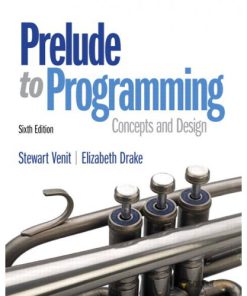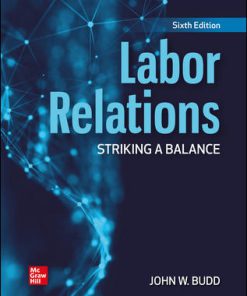Test Bank for Majority-Minority Relations Census Update, 6/E 6th Edition John E. Farley
$35.00 Original price was: $35.00.$26.50Current price is: $26.50.
Test Bank for Majority-Minority Relations Census Update, 6/E 6th Edition John E. Farley
This is completed downloadable of Test Bank for Majority-Minority Relations Census Update, 6/E 6th Edition John E. Farley

Product Details:
- ISBN-10 : 0205006574
- ISBN-13 : 978-0205006571
- Author: John E. Farley
Majority – Minority Relations helps students develop an understanding of the principles and process that influence race and ethnic relations.
This topically organized text is designed to develop students’ understanding of the principles and processes that shape the patterns of relations between racial, ethnic, and other groups in society. Organized by topic, this book provides a more integrated look at the social forces that affect different racial groups.
The Census Update program incorporates 2010 Census data into a course–simply and easily. The components of the Census Update Program include an updated census edition with all charts and graphs–to reflect the results of the 2010 Census. In addition, A Short Introduction to the U.S. Census is available and an updated MySocKit.
Teaching & Learning Experience
- Personalize Learning – MySocKit delivers proven results in helping students succeed, provides engaging experiences that personalize learning, and comes from a trusted partner with educational expertise and a deep commitment to helping students and instructors achieve their goals.
- Improve Critical Thinking – Encourages students to critically evaluate racial inequality and conflict.
- Engage Students – Topical organization helps students delve into the sociology of inter-group relations.
- Explore Theory – Integrated look at the social forces, principles, and processes that impact different racial groups.
- Support Instructors – MySocKit enables instructors to assess student progress and adapt course material to meet the specific needs of the class.
Table of Content:
IN THIS SECTION:
1.) BRIEF
2.) COMPREHENSIVE
BRIEF TABLE OF CONTENTS:
Chapter 1: Orientation: Basic Terms and Concepts
Part I: Social-Psychology and Social Structure as Ways of Understanding Majority-Minority Relations
Chapter 2: Prejudice: Its Forms and Causes
Chapter 3: Reducing Prejudice: How Achievable? How Important?
Chapter 4: Macro-Sociological Perspectives: The Order and Conflict Models
Part II: The Historical Roots of Today’s Intergroup Inequality and Majority-Minority Relations
Chapter 5: Origins and Causes of Ethnic Inequality
Chapter 6: Changing Patterns of Majority-Minority Relations in the United States
Chapter 7: Minority Group Movements and Their Impact on Society
Chapter 8: Changing Values, Goals, and Models: New Thinking on Assimilation, Pluralism, and Separatism
Chapter 9: Cross-Cultural Studies of Majority-Minority Relations
Part III: Majority-Minority Relations in America Today: The Role of Institutional Discrimination
Chapter 10: The Status of Majority and Minority Groups in the United States Today
Chapter 11: The Economic and Health Care Systems and Minority Groups in America
Chapter 12: Living Apart: Housing Segregation in America
Chapter 13: The American Political and Legal System and Majority-Minority Relations
Chapter 14: Education and American Minority Groups
Part IV: Current and Future Issues in Majority-Minority Relations
Chapter 15: Current Trends in Majority-Minority Relations
Chapter 16: Current Debates: Affirmative Action, Immigration, and Race Versus Class
COMPREHENSIVE TABLE OF CONTENTS:
Chapter 1: Orientation: Basic Terms and Concepts
Why Study Race and Ethnic Relations?
Emphasis and Approach of This Book
Basic Terms and Concepts
Summary and Conclusion
Critical Review Questions
Key Terms
Part I: Social Psychology and Social Structure as Ways of Understanding Majority-Minority Relations
Chapter 2: Prejudice: Its Forms and Causes
What Is Prejudice?
Forms of Prejudice
Stereotypes
Causes of Prejudice
Theories About Personality and Prejudice
Social Learning and Symbolic Interactionist Theories of Prejudice
Socioeconomic Status and Prejudice
Summary and Conclusion
Critical Review Questions
Key Terms
Chapter 3: Reducing Prejudice: How Achievable? How Important?
Reducing Prejudice: Some Principles and Approaches
How Important Is Prejudice?
Summary and Conclusion
Critical Review Questions
Key Terms
Chapter 4: Macro-Sociological Perspectives: The Order and Conflict Models
Sociological Versus Social-Psychological Approaches to Majority-Minority Relations
Perspectives in Sociology
Order and Conflict: Two Sociological Perspectives
The Social-Structural Perspectives and Social Problems
The Social-Structural Perspectives and Majority-Minority Relations
An Illustration of the Debate: Culture of Poverty Theory and African American Families
Summary and Conclusion
Critical Review Questions
Key Terms
Part II: The Historical Roots of Today’s Intergroup Inequality and Majority-Minority Relations
Chapter 5: Origins and Causes of Ethnic Inequality
Patterns of Race and Ethnic Relations
The Development of Ethnic Stratification
Origins of Racial and Ethnic Inequality in the United States
Summary and Conclusion
Critical Review Questions
Key Terms
Chapter 6: Changing Patterns of Majority-Minority Relations in the United States
Origins of Contact and Modern-Day Race Relations: A Theory of Internal Colonialism
Evolving Patterns of Black-White Race Relations
Rigid Competitive Race Relations and Other Racial and Ethnic Groups
A Shift to Fluid Competitive Race Relations: America Since World War II
Factors Causing the Changes: The Effects of Urbanization and Industrialization
Summary and Conclusion
Critical Review Questions
Key Terms
Chapter 7: Minority Group Movements and Their Impact on Society
Adaptive Responses
Change-Oriented Responses
A Shift Toward Change-Oriented Responses
The Rising Tide of Protest
Necessary Conditions for Social Movements
Development of These Conditions and the Formation of Minority Social Movements in the United States After World War II
Summary and Conclusion
Critical Review Questions
Key Term
Chapter 8: Changing Values, Goals, and Models: New Thinking on Assimilation, Pluralism, and Separatism
Changing Goals for Minority Group Movements
Three Ideal Models of Intergroup Relations
Assimilation, Pluralism, and Separatism in American Society
Changing Attitudes Toward Assimilation and Pluralism
Summary and Conclusion
Critical Review Questions
Key Terms
Chapter 9: Cross-Cultural Studies of Majority-Minority Relations
Cross-Cultural Evidence on the Effects of Colonization
Societies with Peaceful Intergroup Relations
Cross-Cultural Evidence on the Effects of Urbanization and Modernization
Combined Effects of Colonialism and Degree of Modernization
Number of Racial and Ethnic Groups
Cultural and Demographic Characteristics of Majority and Minority Groups: Brazil and Mexico
Overlapping Versus Crosscutting Cleavages
Territorial Ethnic Base
Language
International Relationships
Racial Versus Ethnic Divisions
International Pressure
Summary and Conclusion
Critical Review Questions
Key Terms
Part III: Majority-Minority Relations in America Today: The Role of Institutional Discrimination
Chapter 10: The Status of Majority and Minority Groups in the United States Today
Major Racial and Ethnic Groups: Overview and General Statistics
Status of Minority Groups in America Today
The Intersection of Race, Gender, and Class Inequality
Summary and Conclusion
Critical Review Questions
Key Terms
Chapter 11: The Economic and Health Care Systems and Minority Groups in America
Wealth and Race: Asset Ownership in America Today
The Economics of Discrimination: Three Theories
Recent Trends and Their Effects on Economic Inequality
The Fiscal Troubles of Cities and Their Impact on Minorities
Health Care and Minorities
Summary and Conclusion
Critical Review Questions
Key Terms
Chapter 12: Living Apart: Housing Segregation in America
Housing Discrimination and Segregation
Housing Segregation Between Blacks and Whites
Causes of Continuing Black-White Segregation
Housing Segregation Among Latinos/as, Asian Americans, and Native Americans
Discrimination in Home Finance and Insurance
Impacts of Segregation
Race, Segregation, and Hurricane Katrina
Summary and Conclusion
Critical Review Questions
Key Terms
Chapter 13: The American Political and Legal System and Majority-Minority Relations
Government in America: Agent of Minority Oppression or Protector of Minority Rights?
The American Legal System and Majority-Minority Relations
Summary and Conclusion
Critical Review Questions
Key Terms
Chapter 14: Education and American Minority Groups
A Brief History of School Segregation Since 1954
The Role of Education: Two Views
Funding of Schools
Cultural and Behavioral Factors in the Education of Minorities
Teachers’ Expectations and Tracking
Linguistic Issues and the Bilingual Education Debate
Test Bias and The Standardized Testing Debate
Lack of Minority Role Models
Racial Bias in the Educational System: An Evaluation
Resolving Problems of Majority-Minority Inequality in Education: Four Approaches
Summary and Conclusion
Critical Review Questions
Key Terms
Part IV: Values, Goals, and Issues of the Present and Future in Majority-Minority Relations
Chapter 15: Current Trends in Majority-Minority Relations
Diversity and Multiculturalism in Work and Education
Hate Group Activity and Hate Crime
Combating Hatred on Campus: Debates and Issues
The Discrimination-Testing Movement
Summary and Conclusion
Critical Review Questions
Key Terms
Chapter 16: Current Debates: Affirmative Action, Immigration, and Race Versus Class
Affirmative Action
The Relative Importance of Race and Class in American Society
Immigration Policy
Summary and Conclusion
Critical Review Questions
Key Terms
Glossary
References
Photo Credits
Name Index
Subject Index
People Also Search:
majority-minority relations census update, 6/e 6th edition john e. farley
majority-minority relations census update, 6/e 6th edition
majority-minority relations census update, 6/e 6th edition john e. farley test bank download pdf
majority-minority relations census update, 6/e 6th edition john e. farley download scribd
You may also like…
Solution Manual
Solution Manual for Aerodynamics for Engineers, 6/E 6th Edition John J. Bertin, Russell M. Cummings












